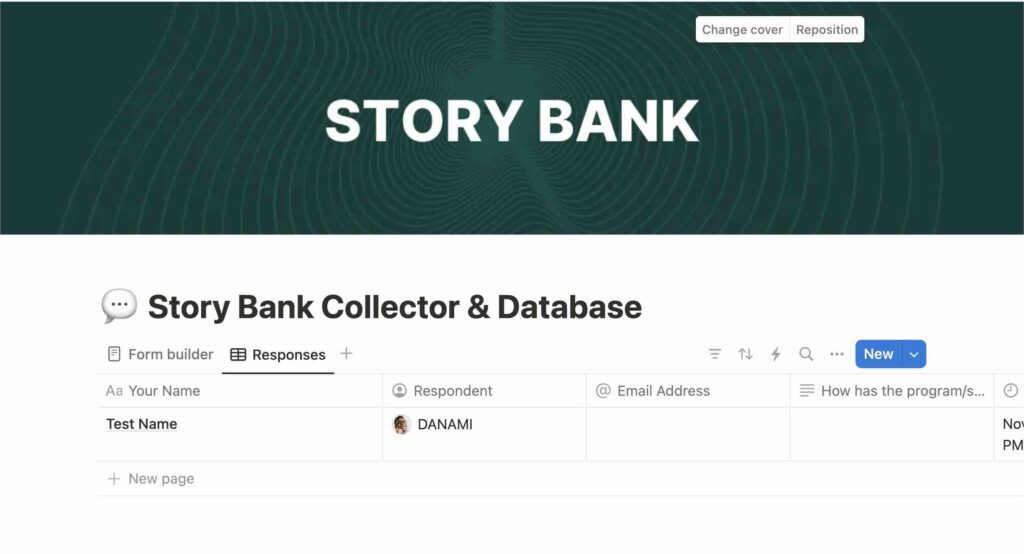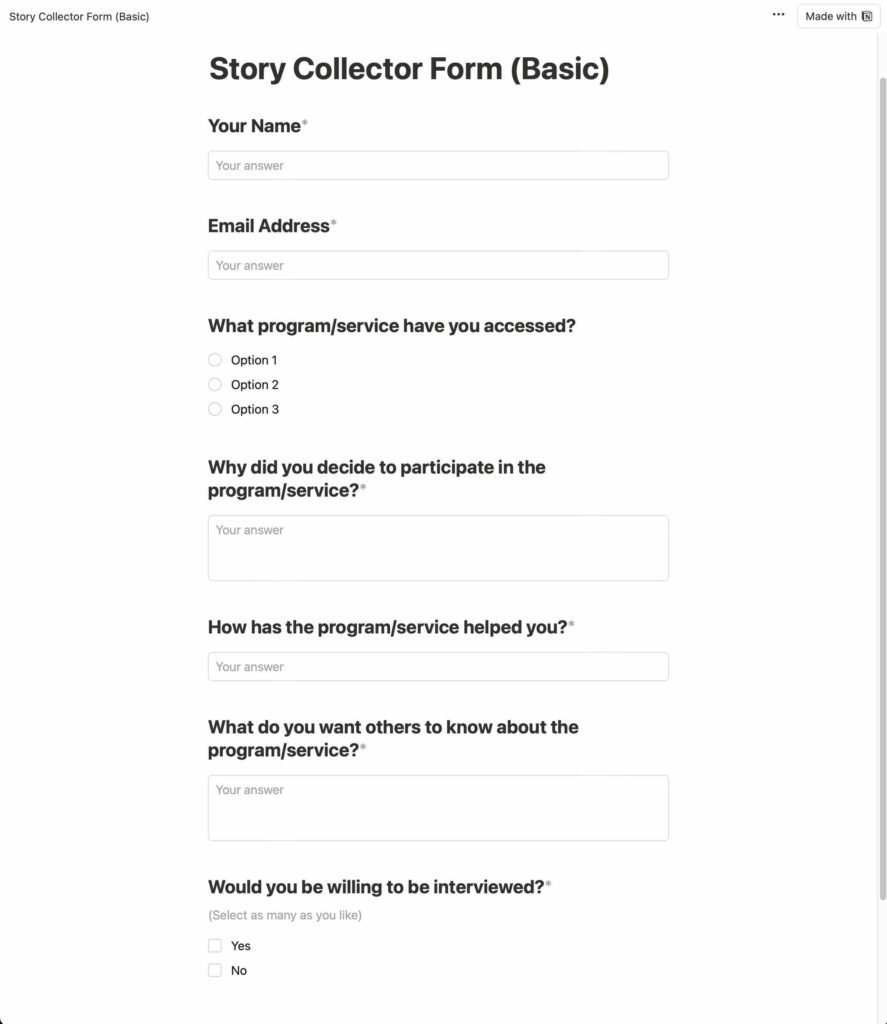Many stories go untold because there’s no system to collect them. You may track outcomes, but the human side is missing. A story bank solves this. This article will walk you through some options for collecting stories for your nonprofit.
Table of contents
Types of Stories Your Nonprofit Needs

To paint a complete picture of your organization, you need many types of stories that support your overall organizational story. These fall into two main categories.
Two primary story type categories.
- Organizational Stories
- People Stories
Organizational Stories
These evergreen stories define your organization. They share your purpose, mission, and values with others.
- Origin story: How your organization started and the problem it wanted to solve.
- Value story aka Why story: Deeper meaning behind what you do. Why do you exist?
- Explainer story: Elevator pitch with more details describing what you do.
- Approach story: How do you go about doing your work? What's different about your way?
People Stories
People stories highlight those connected to your nonprofit. Ronald Pruitt from 4aGoodCause gives five examples.
- Donor stories: Why they give.
- Participant stories: From participants: How you've made a difference in their lives.
- Board members' stories: Why they remain involved.
- Employee stories: Why they stay committed.
- Volunteer stories: Why they serve.
Why Collecting Stories Matters
Goals help you collect the right stories. A good story won’t help if it doesn’t match your goals. Aligning stories makes them more impactful.
Therefore, identifying your goal is the first step in finding the right stories to collect and tell. It's also helpful to determine who will collect stories and a routine for collecting them, such as monthly, quarterly, twice a year, etc. (4agoodcause)
Examples of Organizational Goals
- Fundraising
- Awareness
- Strengthen trust and connection
- Recruitment
- Advocacy
Where to Find Stories for Your Nonprofit
Stories are everywhere—like the wind blowing around you. They appear when people share meaningful experiences and emotions.
For example, a co-worker may feel overwhelmed and disheartened after tirelessly working on a project. On the other hand, a farmer may find hope through an environmental program. A corporate partner may feel pride in witnessing a turtle's hatchling release and realizing their role in preserving a species.
You will find stories in the experiences of others. They are not specific places, although they could be like online reviews or candid testimonials through conversation. You'll see them all around you by learning to see and think in stories.
Tools for Collecting & Storing Stories
Once you find a potential story, you need a way to capture it. The two main methods are surveys and interviews. If you're wondering which tool to use, I recommend both.
Surveys: Self-guided. Ideal for broad, scalable story gathering.
- Google Form (a favorite of Nonprofit Storyteller Vanessa Chase Lockshin)
- Typeform
- SurveyMonkey
- GoodSeeker
- MemoryFox
Interviews: Done together and Interactive. Ideal for deeper exploration.
- In-person with pen and pad or audio recorder (free)
- Phone Calls (free-ish)
- Video calls using Google Meet, Zoom, Descript, or Riverside (paid)
For our documentary, Where Paths Meet, we used surveys to explore story directions and followed up with interviews. Surveys can uncover broad insights, while interviews dive deeper into key stories.
Story Storage Options
You’ll need an accessible place to store your stories—a centralized story bank. Choose an all-in-one platform or set up your system.
Option 1: All-in-One Services
Platforms like GoodSeeker and MemoryFox offer solutions tailored to different needs for efficiently collecting and managing your organization's stories. These platforms simplify storytelling by turning your collected content into actionable, organized narratives.
GoodSeeker
- Purpose: Helps organizations gather and highlight impact stories.
- Features:
- Customizable story collection campaigns with prompts.
- "Share Your Story" pages allow contributors to submit stories with photos or videos.
- Organized into embeddable storyboards by team, values, or skills.
- Add calls to action (e.g., for donations, roles, or signups).
MemoryFox
- Purpose: Designed for nonprofits to collect, organize, and share community stories.
- Features:
- Branded campaigns for story collection (no downloads or logins needed).
- Submissions are stored in a centralized Story Bank with tagging options.
- Built-in tools for creating videos, social posts, or reports (e.g., Canva Integration).
- Includes privacy and consent tools for ethical storytelling.
Option 2: DIY Approach with Notion Forms

For a DIY approach, use two tools: a story collection form and one for storing them. Google Forms, with its free-form feature, works well for collecting stories. However, Notion can serve as both a collector and a database.
Free Notion template for collecting stories and storage.
The cool thing about using Notion Forms is that it automatically connects to a customizable database, making it easy to organize and filter stories by type, keywords, or prompts. You can use separate forms for different stories, like impact stories with prompts for conflict, journey, and outcome. Download the Notion database template here.
Check out our article, 6 Interview Questions for Stronger Impact Stories for specific questions.

Ways to Use Stories from Your Story Bank
The possibilities for using those inspiring stories are endless. Here are a few ideas to spark your creativity—can you see yourself trying any of these?
Internal Usage
- Boost morale by sharing the stories during staff meetings or retreats.
- Share inspiring quotes in reports.
External Usage
- Use quotes for campaigns or grants.
- Update the copy using the story submitter language for authenticity.
- Turn stories into videos.
Bonus: Turn Written Words into Video Stories
Your story bank is also a powerful tool for finding which stories to turn into video stories. It allows your video team to review collected stories and identify the ones with the strongest and most relatable characters. The story bank acts as a pre-vetted resource.
Not every written story needs to become a video.
However, the ones that do can change how people see your work. Video storytelling brings humanity to life in a way words alone can’t, combining sight, sound, and story to create an immersive, emotional connection.
With the right story, video can make your mission memorable.
Why Story Collection Is Worth It
Survey feedback is common, but with a few tweaks, you can go beyond numbers. Collecting stories captures emotional experiences that add depth and context to your data.
The story collection is an upstream effort with a downstream impact. As mentioned, these stories can build trust, inspire action, and highlight your organization's impact.
So, the way to collect stories for your nonprofit is to begin identifying your goals, then use surveys and interviews to capture diverse narratives from donors, participants, and staff, and finally, organize these stories in a searchable story bank.
By following these steps, you’ll create a story bank that fosters connection and empowers you to share compelling narratives across all your initiatives.
- Identify the Types of Stories to Collect
- Match Stories to Organizational Goals
- Choose Methods for Collecting Stories
- Centralize and Organize Your Stories
- Put Your Stories to Work
Download the Notion story bank template to start building your story bank today.
P.S.
In the article, I wanted to offer alternative options and approaches. While my recommendations may not fit everyone, I encourage you to explore Vanessa Chase Lockshin's 7 recommended tools for collecting nonprofit stories.
Related Articles
OpenAI’s ChatGPT and Grammarly were used for revisions and feedback. Check out our AI Ethical Use Statement.
